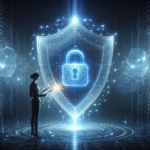In our increasingly digital world, cybersecurity has become a fundamental concern for individuals and organizations alike. As we navigate the vast landscape of the internet, it’s essential to understand the basics of cybersecurity to protect ourselves and our sensitive information from threats like malware, phishing, and data breaches. This guide will introduce you to the key concepts of cybersecurity and provide practical tips to ensure your online safety.
Understanding Cybersecurity
Cybersecurity refers to the practice of defending computers, servers, mobile devices, electronic systems, networks, and data from malicious attacks. As technology evolves, so do the tactics employed by cybercriminals. Therefore, understanding the different types of cyber threats is crucial for everyone who accesses the internet.
Common Cyber Threats
Malware: Short for malicious software, malware encompasses various software types designed to damage or gain unauthorized access to a system. Common forms of malware include viruses, worms, trojans, ransomware, and spyware.
Phishing: Phishing is a devious tactic used by cybercriminals to trick individuals into revealing personal information, such as usernames, passwords, and credit card numbers. Phishing attacks typically occur via email but can also occur through SMS or social media platforms.
Ransomware: Ransomware is a specific type of malware that encrypts a user’s data, demanding payment (a ransom) to unlock it. These attacks can cause significant disruptions and losses for individuals and organizations.
Data Breaches: A data breach occurs when unauthorized individuals gain access to sensitive data, often leading to identity theft or financial losses. Data breaches can result from weak security practices, software vulnerabilities, or insider threats.
DDoS Attacks: Distributed Denial of Service (DDoS) attacks involve overwhelming a system or network with traffic, causing it to slow down or crash. These attacks typically aim to disrupt services and can impact both individuals and businesses.
The Importance of Cyber Hygiene
To navigate today’s digital environment successfully, maintaining good cyber hygiene is essential. Cyber hygiene refers to the practice of maintaining and managing your online presence to protect it from cyber threats. Here are some fundamental practices to help you stay safe online:
Essential Cybersecurity Practices
1. Use Strong, Unique Passwords
Your password is your first line of defense against unauthorized access. Make sure to:
- Create complex, unique passwords for each account. A good password should contain a mix of upper and lower case letters, numbers, and special characters.
- Avoid using easily guessable information, such as birthdays or common words.
- Consider using a passphrase, which is a sequence of random words, for added security.
2. Enable Two-Factor Authentication (2FA)
Two-factor authentication adds an extra layer of security to your accounts. By requiring two forms of identification (something you know, like your password, and something you have, like a mobile device), it significantly reduces the chances of unauthorized access.
3. Keep Software and Devices Updated
Older software is more vulnerable to attacks. Regularly update your operating systems, applications, and devices to ensure they have the latest security patches. Enable automatic updates whenever possible to ensure you’re always protected.
4. Be Wary of Public Wi-Fi
Public Wi-Fi networks are convenient but pose security risks. Avoid accessing sensitive information or conducting financial transactions on public networks. If you must use public Wi-Fi, consider using a virtual private network (VPN) to secure your internet connection.
5. Educate Yourself About Phishing
Be cautious when opening unsolicited emails or messages that ask for personal information. Look for red flags, such as poorly written messages, suspicious links, or unexpected attachments. When in doubt, contact the organization directly using verified contact information.
6. Backup Your Data
Regularly backing up your data ensures that you don’t lose important information in case of a cyber incident. Use external hard drives or cloud storage solutions to keep copies of essential files. Remember to encrypt sensitive data for added security.
7. Use Antivirus and Antimalware Solutions
Investing in reputable antivirus and antimalware software can help protect your devices from malicious threats. Make sure to keep the software updated and perform regular scans.
8. Monitor Your Accounts
Regularly check your financial statements and online accounts for any suspicious activity. Report discrepancies immediately to your bank or service provider.
9. Limit Social Media Sharing
Be mindful of the personal information you share on social media platforms. Cybercriminals often use social engineering techniques to gather information to launch targeted attacks.
Conclusion
Cybersecurity is an ever-evolving field, and remaining vigilant is key to protecting yourself online. By understanding the common threats and implementing essential cybersecurity practices, you can significantly reduce your risk of falling victim to cyberattacks. Remember, your online safety is ultimately in your hands. Stay informed, stay cautious, and enjoy the benefits of a safer digital world.
[ad_2]In the ever-evolving arena of online safety, it’s crucial to stay informed about various aspects of cybersecurity. Understanding the threats we face is an excellent starting point. For instance, if you’re curious about how malicious software operates, you might find it helpful to explore the concept of malware. Cyberattacks often employ tactics like phishing, a method used to deceive individuals into divulging sensitive information. It’s also worth knowing the potential risks associated with data breaches, which can have significant impacts on both personal and organisational levels. As you delve deeper, consider learning about two-factor authentication, a powerful tool in fortifying your online accounts. Staying informed will empower you to navigate the digital landscape with greater confidence and security.





